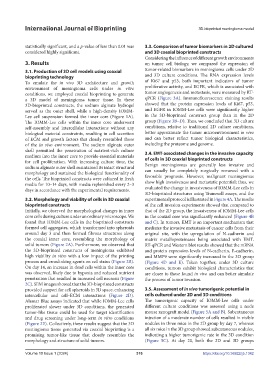Page 324 - IJB-10-1
P. 324
International Journal of Bioprinting 3D-bioprinted meningioma model
statistically significant, and a p-value of less than 0.01 was 3.3. Comparison of tumor biomarkers in 2D cultured
considered highly significant. and 3D coaxial bioprinted constructs
Considering the influence of different growth environments
3. Results on tumor cell biology, we compared the expression of
3.1. Production of 3D cell models using coaxial tumor-related biomarkers in meningioma cells under 2D
bioprinting technology and 3D culture conditions. The RNA expression levels
To emulate the in vivo 3D architecture and growth of Ki67 and p53, both important indicators of tumor
environment of meningioma cells under in vitro proliferative activity, and EGFR, which is associated with
conditions, we employed coaxial bioprinting to generate tumor angiogenesis and metastasis, were measured by RT-
a 3D model of meningioma tumor tissue. In these qPCR (Figure 3A). Immunofluorescence staining results
3D-bioprinted constructs, the sodium alginate hydrogel showed that the protein expression levels of Ki67, p53,
served as the outer shell, while a high-density IOMM- and EGFR in IOMM-Lee cells were significantly higher
Lee cell suspension formed the inner core (Figure 1A). in the 3D-bioprinted construct group than in the 2D
The IOMM-Lee cells within the inner core underwent group (Figure 3B–D). Thus, we concluded that 3D culture
self-assembly and intercellular interactions without any conditions, relative to traditional 2D culture conditions,
biological material constraints, resulting in cell secretion better approximate the tumor microenvironment in vivo
of ECM and growth factors that closely resembled those and can better reflect tumor biological characteristics,
of the in vivo environment. The sodium alginate outer including the proteome and genome.
shell permitted the penetration of nutrient-rich culture 3.4. EMT-associated changes in the invasive capacity
medium into the inner core to provide essential materials of cells in 3D coaxial bioprinted constructs
for cell proliferation. With increasing culture time, the
sodium alginate outer shell maintained its intact structural Benign meningiomas are generally less invasive and
morphology and sustained the biological functionality of can usually be completely surgically removed with a
the cells. The bioprinted constructs were cultured in fresh favorable prognosis. However, malignant meningiomas
media for 10–14 days, with media replenished every 2–3 show high invasiveness and metastatic potential; thus, we
days in accordance with the experimental requirements. evaluated the change in invasiveness of IOMM-Lee cells in
3D-bioprinted structures using Transwell assays, and the
3.2. Morphology and viability of cells in 3D coaxial experimental protocol is illustrated in Figure 4A. The results
bioprinted constructs of the cell invasion experiments showed that compared to
Initially, we observed the morphological changes in inner that of the 2D group, the invasiveness of IOMM-Lee cells
core cells during culture under an ordinary microscope. We in the coaxial core was significantly enhanced (Figure 4B
found that IOMM-Lee cells in the bioprinted constructs and C). In tumors, EMT is an important mechanism that
formed cell aggregates, which transformed into spheroids mediates the invasive metastasis of cancer cells from their
around day 3 and then formed fibrous structures along original site, with the upregulation of N-cadherin and
the coaxial inner core, resembling the morphology of matrix metalloproteinases being associated with EMT.
solid tumors (Figure 2A). Furthermore, we observed that RT-qPCR and Western blot results showed that the mRNA
the 3D-bioprinted constructs of meningioma exhibited and protein expression levels of N-cadherin, E-cadherin,
high viability in vitro with a low impact of the printing and MMP9 were significantly increased in the 3D group
process and crosslinking agents on cell status (Figure 2B). (Figure 4D and E). Taken together, under 3D culture
On day 14, an increase in dead cells within the inner core conditions, tumors exhibit biological characteristics that
was observed, likely due to hypoxia and reduced nutrient are closer to those found in vivo and can better simulate
penetration that resulted in increased cell necrosis (Figure the process of tumor invasion.
2C). SEM images showed that the 3D-bioprinted constructs
provided support for cell spheroids in 3D space, enhancing 3.5. Assessment of in vivo tumorigenic potential in
intercellular and cell–ECM interactions (Figure 2D). cells cultured under 2D and 3D conditions
Alamar Blue assays indicated that while IOMM-Lee cells The tumorigenic capacity of IOMM-Lee cells under
proliferated slower under 3D conditions, the generated different culture conditions was assessed using a nude
tumor-like tissue could be used for target identification mouse xenograft model (Figure 5A and B). Subcutaneous
and drug screening under long-term in vitro conditions injection of a moderate number of cells resulted in visible
(Figure 2E). Collectively, these results suggest that the 3D nodules in three mice in the 2D group by day 7, whereas
meningioma tissue generated via coaxial bioprinting is a all six mice in the 3D group showed subcutaneous nodules,
promising tumor-like tissue that closely resembles the indicating a higher tumorigenic rate in the 3D condition
morphology and structure of solid tumors. (Figure 5C). At day 20, both the 2D and 3D groups
Volume 10 Issue 1 (2024) 316 https://doi.org/10.36922/ijb.1342

